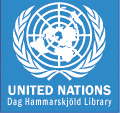|
|
||
|
TAGS
|
||
|
|
||
|
|
||
|
|
||
|
|
||
|
|
||
|
|
||
| |
| |
| |
IntroductionThe online Thesaurus is the authority file of subject and geographic name headings which constitute the controlled vocabulary for subject indexing and cataloguing of material in UNBISnet, the online Library catalogue. Cataloguers and indexers of agencies which use the Thesaurus may propose new terms or changes to old terms by submitting a request form, the Thesaurus Term Worksheet, through their designated Focal Points.The
principal fields are: Because the Thesaurus is fully multilingual, a separate MARC tag is provided for each language version of each field. Consequently, there is a Heading (English) field, a Heading (Arabic) field, a Heading (Chinese) field, etc. The exceptions to this are the Subject Category Code and See Also Tracing fields--the non-English displays of these fields are generated automatically from English tags in the non-MARC format database in which the Thesaurus is maintained. It should also be noted that currently the non-roman scripts of Thesaurus terms are not implemented in UNBISnet and that although French and Spanish fields are included in UNBISnet Thesaurus records, they are not indexed and thus not searchable. Searches may be conducted in all United Nations official languages in the online version of the Thesaurus. Names of countries and major geographic regions are treated as Thesaurus terms and are incorporated into the hierarchical structure of the Thesaurus. Although established headings for all other geographic names are maintained in the Thesaurus database, they are not incorporated into its hierarchical structure. See From cross-references may be present, but there is no reciprocal cross-reference structure between related terms, nor is any attempt made to represent the term in the six languages of the Thesaurus. The English conventional form of place-name is generally preferred, in line with AACR2, but sometimes the spelling employed in UN maps prevails. |
